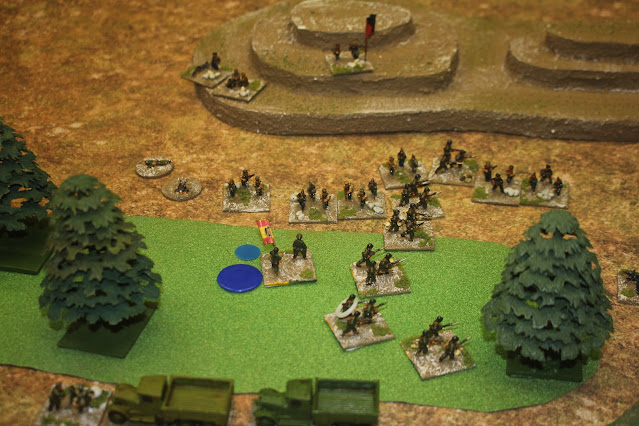We revisited the Majorca scenario from a week or so back last night. We were much reduced in numbers and had a small cast change, but it was still worth giving it a go to see if there was a way for the Nationalists to win.
For the game I made some changes to the units' values, increasing the Nationalist fire effectiveness and giving them a light mortar as infantry support. I was unhappy with giving the Nationalists such high values in the original game, but on reflection this is all about differentials. In this campaign/battle the Nationalists are really so much better that widening the gap and flexing the unit definitions was the only way to go.
I was expecting four in Shedquarters, but Richard ended up Zooming in as he was incubating a cold, and I misunderstood Steve's message so he was online too. The physical attendees were Phil & Tim, who ran the Republicans, whilst Richard and Steve gave me instructions to move the Nationalists.
Compared to the last game the Nationalists chose a different approach, and came on at the other two entry points. These are closer to the enemy, and are nearer usable cover. Steve's early push on the village was spearheaded by the Guardia Civil. They got caught early doors by the Republican air force, but emerged unscathed, having previously shot up the village a bit.
The local fascist militia, the Falange, leapfrogged the Guardia Civil and stormed the village. Richard's personal distain for their real world counterparts means he has little regard for their longevity on the tabletop.
As the Falange had used all their activations, Phil sent in an attack with his other militia, supported by MGs.
This proved to be a bit abortive, and Phil's men ended up back on their start positions in Disorder.
At the other end of the board Richard brought on his motorised infantry battalion, and deployed into the wood, ready to take on the Anarchists occupying the hills.
Then the Italian volunteer air force turned up, and strafed the Republican guns.
This was enough to cause the gunners to flee in terror, never to be seen again.
Richard responded immediately, and expelled the Anarchists from the wood, and inflicted a lot of hits.
Yes. Quite a lot of hits. Of course, this has used up all of Richard's activations for the turn.
Then the Italian airplanes return, but what's this? They mistake Richard's men for Republicans, and shoot them up a bit. Luckily the damage is minimal, and the Nationalists pass their Terror Test.
Richard decides to avoid being attacked again by the rampant column, and sends his men to attack the other Anarchists, the ones he beat up earlier. Due to the large number of unallocated hits which have not been cleared by reorganisation, the Anarchists fall apart and rout.
Back to the village, and Phil's militia have another go at evicting the Falangists from their position.
It doesn't end well. The unit, except for the MG company providing covering fire, is wiped out.
We then ran out of time. We'd had a slow start - the weather was horrible with ice and freezing fog, which slowed arrivals. Then we had some problems with players working out exactly where units were and so on, so the first turn took much longer than expected. We probably needed at least four full turns (which is what I think we played last time) to get a result.
The scenario came closer to the historic outcome this time round, and I think that another turn would have given a Nationalist victory. The Republicans were close to breaking, having lost several units. Boosting the power of the Nationalists helped here, but I think the change in tactics and arrival points made a real difference too.
The loss of half of the Nationalist artillery early on slowed them down considerably, and they never got the infantry mortar into action. Having said that, the mortar crew played a vital role in stopping the Nationalist regulars in the woods being overwhelmed, as their presence prevented the Anarchists getting a 2:1 advantage. Just.
In conclusion, I still don't think I have got the scenario exactly right, but it provides a solid evening's entertainment.
























Once again another nice looking game. It is always interesting to refight a game. Often after a game we sit and discuss what went right or wrong and tinker with the orbats for a refight to re-test rules or ideas.
ReplyDeleteI don't often re-run scenarios, as I find it a bit like the video game approach of "live, die, repeat", although I accept that I'm a bit odd in that respect. good to paly a game without armour and hardly any heavy weapons.
DeleteInteresting change of battle flow from Game #1. I wonder which drove the reversal more? Was it the OB tweaks or the strategy change? Or maybe the dice?
ReplyDeleteI would go with the orbat change and strategy change in equal measure. The dice played their part, as always, but the only truly outrageous piece of luck was the strafing run on the Republican artillery & the resultant terror test. However if Richard had got his artillery deployment right that wouldn't have mattered anyway, as the guns would have been pinned.
Delete